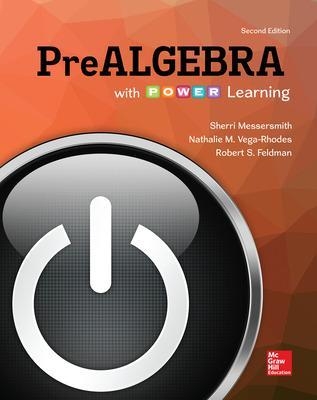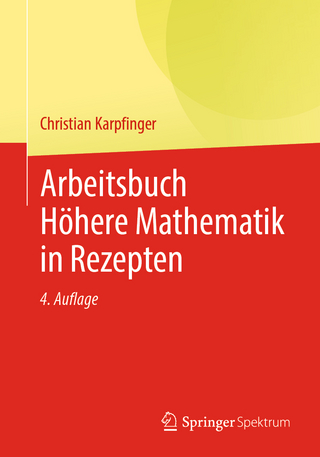
Prealgebra with P.O.W.E.R. Learning
McGraw-Hill Education (Verlag)
978-1-259-61029-5 (ISBN)
Sherri Messersmith has been teaching at College of DuPage in Glen Ellyn, Illinois, since 1994. She has over 25 years of experience teaching many different courses from developmental mathematics through calculus. She earned a bachelor of science degree in the teaching of mathematics at the University of Illinois at Urbana-Champaign and went on to teach at the high level for two years. Sherri returned to UIUC and earned a master of science in applied mathematics and stayed on at the university to teach and coordinate large sections of undergraduate math courses. Sherri has authored several textbook, and she has also appeared in videos accompanying several McGraw-Hill texts. Sherri lives outside of Chicago with her husband, Phil, and their daughters, Alex and Cailen. In her precious free time, she likes to read, play the guitar, and travel -- the manuscripts for this and her previous books have accompanied her from Spain to Greece and many points in between. Nathalie Vega-Rhodes’ career in higher education began seventeen years ago and has encompassed a number of student-focused positions. For nearly a decade, she has taught mathematics ranging from developmental courses to calculus, as well as student success courses. She holds a Bachelor of Arts in Mathematics from the University of Houston and a Master of Science in Mathematics from the University of Houston—Clear Lake. In addition to teaching, as Mathematics Technology Coordinator at Lone Star College—Kingwood, she assists math faculty with technology-related pedagogical and implementation strategies. Her earliest work in higher education focused on academic support, first as a tutor and supplemental instruction (SI) leader, and then as a coordinator for a math tutoring and SI program. In her free time, Nathalie enjoys scuba diving and traveling with her husband, hanging out with her dog, and reading. Bob Feldman still remembers those moments of being overwhelmed when he started college at Wesleyan University. “I wondered whether I was up to the challenges that faced me,” he recalls, “and—although I never would have admitted it at the time—I really had no idea what it took to be successful at college.” That experience, along with his encounters with many students during his own teaching career, led to a life-long interest in helping students navigate the critical transition that they face at the start of their own college careers. Professor Feldman, who went on to receive a doctorate in psychology from the University of Wisconsin–Madison, is now Deputy Chancellor and Professor of Psychological and Brain Sciences at the University of Massachusetts Amherst. He is founding director of POWER Up for Student Success, the first-year experience course for incoming students. Professor Feldman’s proudest professional accomplishment is winning the College Outstanding Teaching Award at UMass. He also has been named a Hewlett Teaching Fellow and was Senior Online Instruction Fellow. He has taught courses at Mount Holyoke College, Wesleyan University, and Virginia Commonwealth University. Professor Feldman is a Fellow of the American Psychological Association, the Association for Psychological Science, and the American Association for the Advancement of Science. He is a winner of a Fulbright Senior Research Scholar and Lecturer award and has written over 200 scientific articles, book chapters, and books. His books, some of which have been translated into Spanish, French, Portuguese, Dutch, Japanese, and Chinese, include Improving the First Year of College: Research and Practice; Understanding Psychology, 12/e; and Development Across the Life Span, 7/e. His research interests encompass the study of honesty and truthfulness in everyday life, development of nonverbal behavior in children, and the social psychology of education. His research has been supported by grants from the National Institute of Mental Health and the National Institute on Disabilities and Rehabilitation Research. With the last of his three children completing college, Professor Feldman occupies his spare time with pretty decent cooking and earnest, but admittedly unpolished, piano playing. He also loves to travel. He lives with his wife, who is an educational psychologist, in a home overlooking the Holyoke mountain range in western Massachusetts.
Prealgebra with P.O.W.E.R. Learning, 2nd EditionChapter 1: Operations with IntegersStudy Strategies: An Introduction to the P.O.W.E.R. Framework
Section 1.1Place Value and RoundingSection 1.2Introduction to IntegersSection 1.3Adding IntegersSection 1.4Subtracting IntegersSection 1.5Estimating a Sum or DifferenceSection 1.6Multiplying Integers and Estimation Section 1.7Dividing Integers and EstimationPutting It All TogetherSection 1.8Exponents, Roots, and Order of OperationsGroup ActivityemPOWERme: Who's in Charge?
Chapter 1 SummaryChapter 1 ReviewChapter 1 TestChapter 2: Expressions and EquationsStudy Strategies: Strategies for Reading Math (and other) Textbooks
Section 2.1Introduction to Algebra Section 2.2Simplifying Expressions Section 2.3Solving Linear Equations Part I Section 2.4Solving Linear Equations Part II Section 2.5Solving Linear Equations Part III Section 2.6Solve Applied Problems Involving One UnknownSection 2.7Solve Applied Problems Involving Two UnknownsGroup ActivityemPOWERme: Discover Your Reading Attention Span
Chapter SummaryChapter 2 ReviewChapter 2 TestCumulative Review for Chapters 1-2Chapter 3: Operations with Signed FractionsStudy Strategies: Time ManagementSection 3.1Introduction to Signed Fractions Section 3.2Writing Fractions in Lowest Terms Section 3.3Multiplying and Dividing Signed Fractions Section 3.4Adding and Subtracting Like Fractions and Finding a Least Common Denominator Section 3.5Adding and Subtracting Unlike Fractions Section 3.6Operations with Mixed Numbers Putting It All Together Section 3.7Order Relations and Order of Operations Section 3.8Solving Equations Containing FractionsGroup ActivityemPOWERme: Find Your Procrastination QuotientChapter SummaryChapter 3 ReviewChapter 3 TestCumulative Review for Chapters 1-3 Chapter 4: Basic Geometry Concepts and AlgebraStudy Strategies: Taking Notes in Class
Section 4.1 Introduction to Geometry Section 4.2Rectangles, Squares, Parallelograms, and Trapezoids Section 4.3Triangles Section 4.4Volume and Surface Area Putting It All Together Section 4.5Solving Geometry Applications Using Algebra Group ActivityemPOWERme: Active Listening
Chapter SummaryChapter 4 ReviewChapter 4 TestCumulative Review for Chapters 1-4Chapter 5: Signed DecimalsStudy Strategies: Taking Math TestsSection 5.1Reading and Writing Decimals Section 5.2Rounding Decimals Section 5.3Adding and Subtracting Signed DecimalsSection 5.4Multiplying Signed Decimals Section 5.5Dividing Signed Decimals and Order of Operations Putting It All TogetherSection 5.6Writing Fractions as Decimals Section 5.7Mean, Median, and Mode Section 5.8Solving Equations Containing Decimals Section 5.9Square Roots and the Pythagorean Theorem Section 5.10Circles, Spheres, Cylinders, and ConesGroup ActivityemPOWERme: Is Anxiety the Hardest Problem on the Test? Chapter SummaryChapter 5 ReviewChapter 5 TestCumulative Review for Chapters 1-5Chapter 6: Ratios, Rates, and ProportionsStudy Strategies: Doing Math Homework
Section 6.1Ratios Section 6.2Rates Section 6.3Proportions Section 6.4Solve ProportionsSection 6.5Solve Applied Problems Involving Proportions Section 6.6Angles Section 6.7Solve Applied Problems Involving Congruent and Similar TrianglesGroup ActivityemPOWERme: The Right Approach for Homework
Chapter SummaryChapter 6 ReviewChapter 6 TestCumulative Review for Chapters 1-6Chapter 7: Measurement and ConversionStudy Strategies: Know Your School
Section 7.1Using U.S. Customary Measurements Section 7.2The Metric System: Length Section 7.3The Metric System: Capacity and Weight (Mass) Section 7.4Solve Applied Problems Involving Metric Units Section 7.5Metric – U.S. Customary Conversions and TemperatureGroup ActivityemPOWERme: My School
Chapter SummaryChapter 7 ReviewChapter 7 TestCumulative Review for Chapters 1-7Chapter 8: PercentsStudy Strategies: Using the Internet to Supplement Your Learning
Section 8.1Percents, Fractions, and Decimals Section 8.2Compute Basic Percents Mentally Section 8.3Use an Equation to Solve Percent Problems Section 8.4Solve Applications Involving Percents Putting It All Together Section 8.5More Applications with Percents Section 8.6Simple and Compound Interest Group ActivityemPOWERme: The Internet, Learning, and Me
Chapter SummaryChapter 8 ReviewChapter 8 TestCumulative Review for Chapters 1-8Chapter 9: Graphs and the Rectangular Coordinate SystemStudy Strategies: Beginning Financial Literacy
Section 9.1Reading Tables, Pictographs, Bar Graphs, and Line Graphs Section 9.2Frequency Distributions and HistogramsSection 9.3Using and Making Circle GraphsSection 9.4Introduction to Linear Equations in Two Variables Section 9.5Graphing Linear Equations in Two Variables Group ActivityemPOWERme: Discover Your Personal Financial Philosophy
Chapter SummaryChapter 9 ReviewChapter 9 TestCumulative Review for Chapters 1-9Chapter 10: The Rules of Exponents and PolynomialsStudy Strategies: Improving Your Memory
Section 10.1The Product Rule and Power Rules Section 10.2Integer Exponents and the Quotient RulePutting It All Together
Section 10.3Scientific NotationSection 10.4Adding and Subtracting PolynomialsSection 10.5Multiplying PolynomialsGroup ActivityemPOWERme: What's Your Memory Style?
Chapter SummaryChapter 10 ReviewChapter 10 TestCumulative Review for Chapters 1-10Chapter 11 (Online): Transition to AlgebraStudy Strategies: The Writing Process
Section 11.1 Sets of NumbersSection 11.2 More on Solving Linear EquationsSection 11.3Solve a Formula for a Specific VariableSection 11.4Solving Linear Inequalities in One VariableGroup ActivityemPOWERme: Writing Clearly
Appendix A: Whole Number ArithmeticSection A.1Adding Whole NumbersSection A.2Subtracting Whole NumbersSection A.3Multiplying Whole NumbersSection A.4Introduction to Division and Short DivisionSection A.5Long Division of Whole Numbers Appendix B (Online)Section B.1 Deriving the Area of a Parallelogram and the Area of a TriangleSection B.2 Inductive and Deductive Reasoning
| Erscheinungsdatum | 02.03.2018 |
|---|---|
| Zusatzinfo | 1231 Illustrations |
| Verlagsort | OH |
| Sprache | englisch |
| Maße | 216 x 272 mm |
| Gewicht | 1560 g |
| Themenwelt | Mathematik / Informatik ► Mathematik ► Algebra |
| ISBN-10 | 1-259-61029-2 / 1259610292 |
| ISBN-13 | 978-1-259-61029-5 / 9781259610295 |
| Zustand | Neuware |
| Haben Sie eine Frage zum Produkt? |
aus dem Bereich


